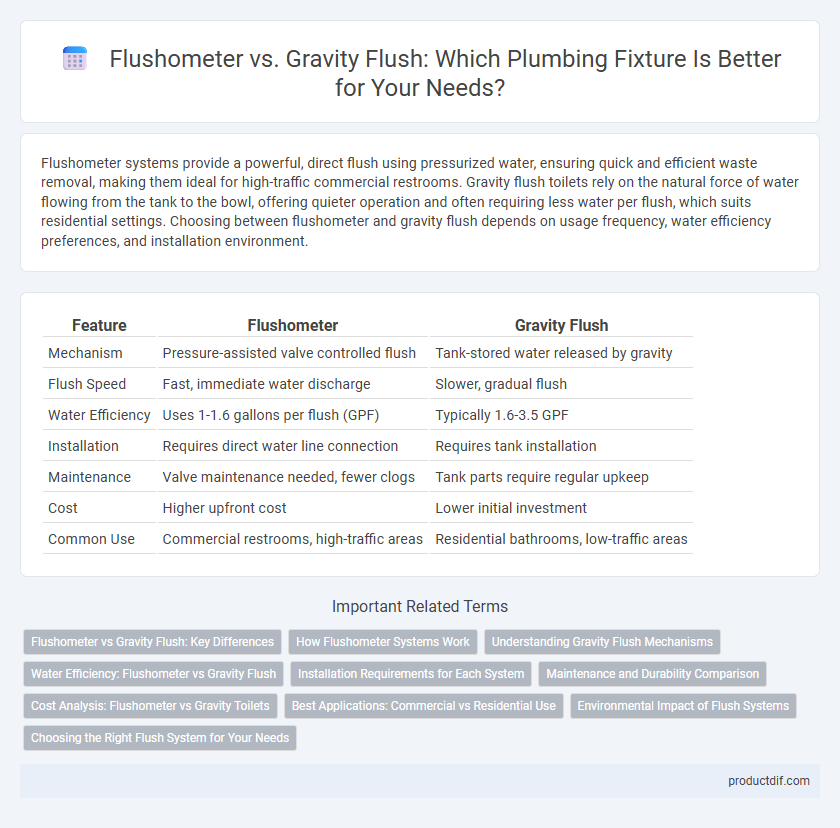Flushometer systems provide a powerful, direct flush using pressurized water, ensuring quick and efficient waste removal, making them ideal for high-traffic commercial restrooms. Gravity flush toilets rely on the natural force of water flowing from the tank to the bowl, offering quieter operation and often requiring less water per flush, which suits residential settings. Choosing between flushometer and gravity flush depends on usage frequency, water efficiency preferences, and installation environment.
Table of Comparison
| Feature | Flushometer | Gravity Flush |
|---|---|---|
| Mechanism | Pressure-assisted valve controlled flush | Tank-stored water released by gravity |
| Flush Speed | Fast, immediate water discharge | Slower, gradual flush |
| Water Efficiency | Uses 1-1.6 gallons per flush (GPF) | Typically 1.6-3.5 GPF |
| Installation | Requires direct water line connection | Requires tank installation |
| Maintenance | Valve maintenance needed, fewer clogs | Tank parts require regular upkeep |
| Cost | Higher upfront cost | Lower initial investment |
| Common Use | Commercial restrooms, high-traffic areas | Residential bathrooms, low-traffic areas |
Flushometer vs Gravity Flush: Key Differences
Flushometer systems deliver water directly from the supply line at high pressure for rapid, powerful flushing, ideal for commercial and high-traffic restrooms. Gravity flush tanks rely on stored water and the force of gravity to clear the bowl, offering quieter operation and lower water usage per flush, commonly found in residential bathrooms. The key differences include flushing mechanism efficiency, water pressure dependency, and maintenance complexity, with flushometers providing strong, immediate flushes and gravity flushes emphasizing water conservation and simplicity.
How Flushometer Systems Work
Flushometer systems operate by using pressurized water directly from the supply line, bypassing the need for a gravity-fed tank. When activated, the flush valve rapidly releases a preset volume of water, providing a powerful and efficient flush ideal for high-traffic commercial restrooms. This mechanism ensures consistent water pressure and flush performance while reducing water waste compared to gravity flush systems.
Understanding Gravity Flush Mechanisms
Gravity flush mechanisms rely on water stored in a tank positioned above the toilet bowl to create flushing pressure through the force of gravity. This system allows for controlled water release with each flush, ensuring efficient waste removal while conserving water compared to traditional flushometers. Understanding the balance of tank height, water volume, and valve operation is crucial for optimizing gravity flush performance and minimizing maintenance issues.
Water Efficiency: Flushometer vs Gravity Flush
Flushometer systems use pressurized water directly from the supply line, enabling powerful and efficient flushing with significantly less water per flush compared to gravity toilets, which rely on a stored tank. Typically, flushometers consume about 1.0 to 1.6 gallons per flush (GPF), while gravity flushometers use 1.6 to 3.5 GPF, resulting in higher water savings for commercial and high-traffic environments. WaterSense-labeled flushometers meet EPA water efficiency criteria, making them more environmentally sustainable than traditional gravity flush fixtures.
Installation Requirements for Each System
Flushometer systems require professional installation with access to high-pressure water supply and precise calibration for optimal performance, often involving wall-mounted units and connection to a pressurized line. Gravity flush toilets demand simpler installation, typically involving a standard flange and water tank that uses gravity to release water, making them suitable for residential settings with standard water pressure. Proper installation of either system ensures efficient flushing while minimizing water usage and maintenance needs.
Maintenance and Durability Comparison
Flushometers offer superior durability with fewer moving parts and metal construction, reducing wear and maintenance frequency compared to gravity flush systems that rely on a tank and flapper valve prone to leaks and component replacement. Gravity flush fixtures require regular inspection of the tank, flapper, and fill valve to prevent common issues like running toilets and reduced flush efficiency, increasing maintenance demands. The robust design of flushometer valves ensures longer service life, making them ideal for high-traffic commercial restrooms with minimal downtime.
Cost Analysis: Flushometer vs Gravity Toilets
Flushometer toilets typically have a higher upfront cost compared to gravity flush toilets due to their complex valve mechanisms and durable materials designed for commercial use. Maintenance expenses for flushometer systems can also be greater because of the need for specialized parts and more frequent servicing in high-usage environments. Gravity flush toilets usually offer lower installation and repair costs, making them more budget-friendly for residential applications where water pressure demands are less intense.
Best Applications: Commercial vs Residential Use
Flushometers are best suited for commercial applications due to their high efficiency and quick refill times, supporting heavy traffic in public restrooms. Gravity flush systems are ideal for residential use, offering quieter operation and lower water pressure requirements suitable for home plumbing. The choice between flushometer and gravity flush depends on usage frequency, water pressure, and maintenance needs in the target environment.
Environmental Impact of Flush Systems
Flushometer systems use less water per flush, typically around 1.28 gallons, contributing to significant water conservation compared to traditional gravity flush toilets that use 1.6 gallons or more. The reduced water usage in flushometers decreases environmental strain by lowering water demand and minimizing wastewater treatment needs. Energy consumption for refill processes is also lower in flushometer systems, enhancing their overall sustainability profile.
Choosing the Right Flush System for Your Needs
Flushometers provide powerful and immediate water release, ideal for high-traffic commercial restrooms requiring rapid, efficient flushing with minimal water use. Gravity flush systems rely on tank-stored water and are better suited for residential settings where quieter operation and lower initial costs matter more than speed. Selecting the right flush system depends on usage frequency, water efficiency goals, and installation environment, with flushometers excelling in durability and gravity flushers offering simplicity and cost-effectiveness.
flushometer vs gravity flush Infographic

 productdif.com
productdif.com